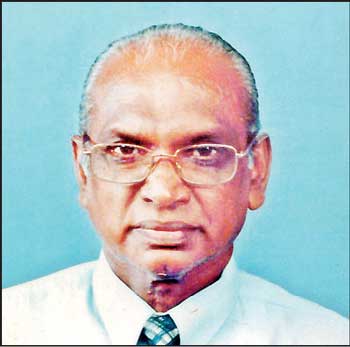Sunday Apr 20, 2025
Sunday Apr 20, 2025
Saturday, 1 June 2024 00:00 - - {{hitsCtrl.values.hits}}
 By Jagath De Silva
By Jagath De Silva
“Viduhala Apa Mavu Dharmasoka” by Godwin I. De Silva is a remarkable testament to the history and legacy of Dharmasoka College, meticulously compiled by a distinguished alumnus and former principal of the college. Godwin I. De Silva’s work delves deep into the origins of the school, shedding light on its inception and the challenges faced by its founder, Mudliyar Santiago Thomas De Silva.
Author De Silva, a distinguished alumnus and former principal of Dharmasoka College, brings a wealth of personal and professional experience to his writing. Having graduated from the University of Peradeniya in 1964 with a BA (Hons) in Geography, De Silva’s deep connection to his alma mater is evident throughout the book. His tenure as principal from 1987 to 1998 provided him with firsthand insight into the inner workings of the school, making him uniquely qualified to chronicle its history.
Beyond his academic and professional achievements, Godwin I. De Silva’s involvement in the arts and culture of Sri Lanka adds a layer of richness to his writing. As a member of the initial cast of the “Sinhabahu” stage play, a masterpiece by Professor Ediriweera Sarathchandra, De Silva has a deep appreciation for the cultural heritage of his country.
 Godwin I. De Silva’s dedication to preserving the history of Dharmasoka College is commendable, particularly considering the challenges and uncertainties surrounding its inception. His meticulous research, coupled with his passion for education and enlightenment, shines through in every page of ‘Viduhala Apa Mavu Dharmasoka.’ At the age of 84, De Silva’s intellectual endeavour and commitment to his alma mater are truly inspiring, and he deserves commendation for his tireless efforts.
Godwin I. De Silva’s dedication to preserving the history of Dharmasoka College is commendable, particularly considering the challenges and uncertainties surrounding its inception. His meticulous research, coupled with his passion for education and enlightenment, shines through in every page of ‘Viduhala Apa Mavu Dharmasoka.’ At the age of 84, De Silva’s intellectual endeavour and commitment to his alma mater are truly inspiring, and he deserves commendation for his tireless efforts.
The book begins by setting the stage, painting a vibrant picture of Ambalangoda as a centre of intellectual and educational activity, populated by renowned scholars, Buddhist priests, and bilingual intellectuals. This contextual background provides a rich tapestry against which the founding of Dharmasoka College unfolds.
Godwin I. De Silva then delves into the social and educational status of Ceylon and Ambalangoda before the establishment of Dharmasoka College, highlighting the existing educational institutions and their contributions to the local community. This section serves as a foundation for understanding the need and context for the creation of Dharmasoka College.
The author meticulously explores the birth of Dharmasoka College, addressing various arguments and opinions about its inception. Through a thorough examination of written and oral evidence, De Silva establishes 1913 as the definitive year of the school’s birth, dispelling any doubts or contradictions. This book is the first volume in the history of Dharmasoka College, covering the period from 1913 to 1962.
As the narrative progresses, De Silva chronicles the growth and development of Dharmasoka College, highlighting key milestones and events that shaped its early years. He pays special attention to the first Golden era of the college under the leadership of an Oxford educated D.T. Wijeratne, during which significant advancements in academics and extracurricular activities were achieved.
A noteworthy aspect of the book is its discussion of the college song, composed by the late maestro Ananda Samarakoone, who also composed the national anthem of Sri Lanka. This musical contribution to the school’s identity and spirit is a testament to the cultural richness of Dharmasoka College.
The book also outlines the subsequent developments at Dharmasoka College, including the second tenure of D.T. Wijeratne as principal, the establishment of the Dharmasoka primary school, and the continuation of the school’s development process.
Finally, De Silva provides a comprehensive list of managers and principals of the school, as well as profiles of some prominent individuals produced by Dharmasoka College. This serves to highlight the school’s impact on its students and the wider community.
In conclusion, “Viduhala Apa Mavu Dharmasoka” is a thorough and insightful exploration of the history and legacy of Dharmasoka College. Through meticulous research and engaging narrative, Godwin I. De Silva has created a valuable resource that celebrates the rich heritage of this esteemed institution.
(The writer is a Past Pupil of Dharmasoka College. He can be reached at [email protected].)
Discover Kapruka, the leading online shopping platform in Sri Lanka, where you can conveniently send Gifts and Flowers to your loved ones for any event including Valentine ’s Day. Explore a wide range of popular Shopping Categories on Kapruka, including Toys, Groceries, Electronics, Birthday Cakes, Fruits, Chocolates, Flower Bouquets, Clothing, Watches, Lingerie, Gift Sets and Jewellery. Also if you’re interested in selling with Kapruka, Partner Central by Kapruka is the best solution to start with. Moreover, through Kapruka Global Shop, you can also enjoy the convenience of purchasing products from renowned platforms like Amazon and eBay and have them delivered to Sri Lanka.
Discover Kapruka, the leading online shopping platform in Sri Lanka, where you can conveniently send Gifts and Flowers to your loved ones for any event including Valentine ’s Day. Explore a wide range of popular Shopping Categories on Kapruka, including Toys, Groceries, Electronics, Birthday Cakes, Fruits, Chocolates, Flower Bouquets, Clothing, Watches, Lingerie, Gift Sets and Jewellery. Also if you’re interested in selling with Kapruka, Partner Central by Kapruka is the best solution to start with. Moreover, through Kapruka Global Shop, you can also enjoy the convenience of purchasing products from renowned platforms like Amazon and eBay and have them delivered to Sri Lanka.